Welcome to our latest and greatest Instagram Stories Benchmark Report!
We’ve updated all your favorite metrics like retention rate, exit rate, replies, and so much more with more handles, Stories, and frames than ever. Looking to compare posts and Stories head to head for a complete look at how your brand is performing on Instagram? We’ve got you.
Download the free PDF and join us for some seriously good Instagram Stories news.
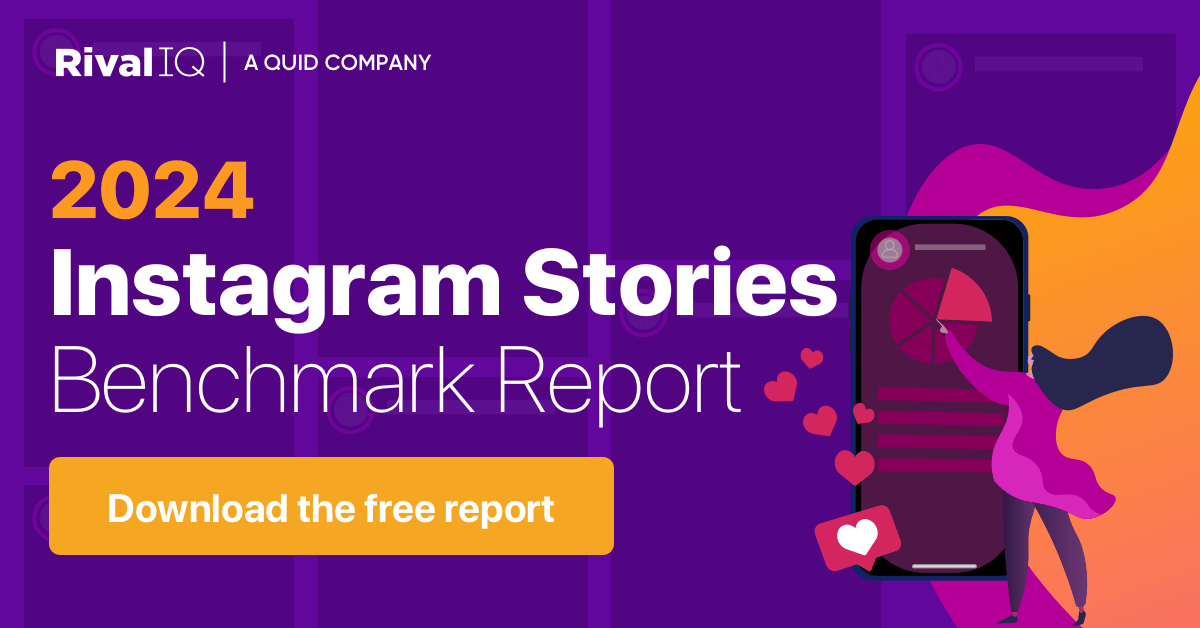
Download the full 2024 Instagram Stories Benchmark Report
Grab your PDF hereKey Instagram Stories Takeaways
Story frequency is up this year
Brands doubled down on Stories creation this year and actually published more Stories than ever before.
Reach rates are on the rise
Your Stories (and posts!) are reaching a larger percentage of your followers compared to last year, which is great news for hardworking content creators everywhere.
Retention rates are flat
Low tap-back and reply rates detracted from retention rates this year, but increases in reach balanced those successes to keep this critical metric flat for brands across the board.
Posts reach more than Stories
Instagram posts continue to see a much higher reach rate than Stories. Hook viewers with posts and deepen their engagement with Stories.
Days with an Instagram Story
Are more Stories really better? The best answer to this age-old question starts with benchmarking how often the average brand publishes a Story in a month.
A quick note on how to read these graphics: we’ve included median performance as well as metrics from the top and bottom 25% of brands so you can understand the full range of Instagram Stories metrics that matter.

Story frequency increased a little this year, with the average brand posting an Instagram Story 13 times per month.
- The top 25% most active brands publish Stories about 20 times a month.
- The least active 25% of brands publish just over 1 Story per week.
Story posting per month hasn’t changed much over the last few years, so it was nice to see a slight increase this year. Brands are still posting about once every other day on average.
Frames Per Day
Let’s talk Stories terminology: in our book, Stories represent a 24-hour period, while frames per day denote the number of individual photos or videos posted within a Story. Finding the “right” number of frames per day for your brand is just as important as figuring out how many Stories you should be posting in a given time period.

Shorter Stories are more common than long ones.
- About 35% of Story activity comprises days with only one frame.
- 1-3 frames account for about 60% of brand activity.
- About 10% of Stories have 7 or more frames, which is down from last year.
You don’t need to post Stories all day, every day to effectively engage with your followers. Finding your own brand’s average number of frames per day and factors that increase your retention rate can help fine-tune your frame frequency strategy.
Retention Rate
Retention rate by frame is one of the most important metrics for understanding how your Instagram Stories are landing with your audience. Why? Sticking around for your frames means you’ve grabbed attention and created a fan, instead of just a follower flitting through. This metric represents the percentage of viewers that have stuck around through any given frame of a Story.
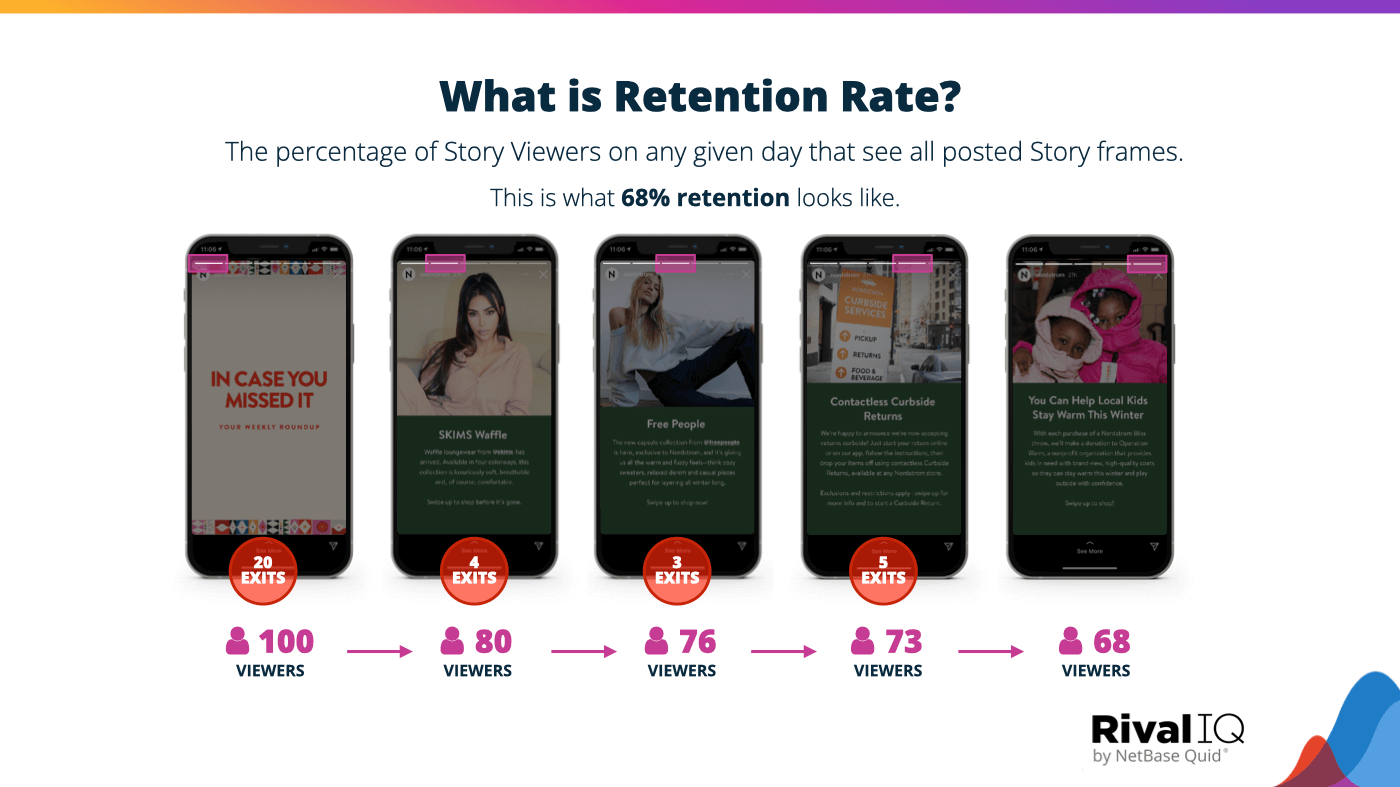
We see the same trend year after year: the more frames you publish, the lower your retention rate.
- Average retention rate was pretty flat this year.
- As always, the biggest dip is from 1 to 2 frames a day as users swipe past the Story.
- After that big initial drop-off, the retention decline slows down and stays above 75% through 7 frames per day.

This metric is one of the truest ways to measure the strength and resonance of your content: retention isn’t influenced by Instagram’s algorithm or in competition with another brand. It’s just your content, your viewer, and whether or not you can keep them tapping forward instead of exiting and moving on to the next Story. Focus on a first frame that hooks viewers, and then don’t be afraid to say everything you need to say: retention drops but doesn’t crater with more frames.

Download the full 2024 Instagram Stories Benchmark Report
Snag yours nowStory Reach Rate
Story reach rate represents the percentage of your followers who are actually seeing your Stories. It’s hard to grab the attention of your full follower count every time you post a Story, so it’s important to measure just how many of them you’re reaching.
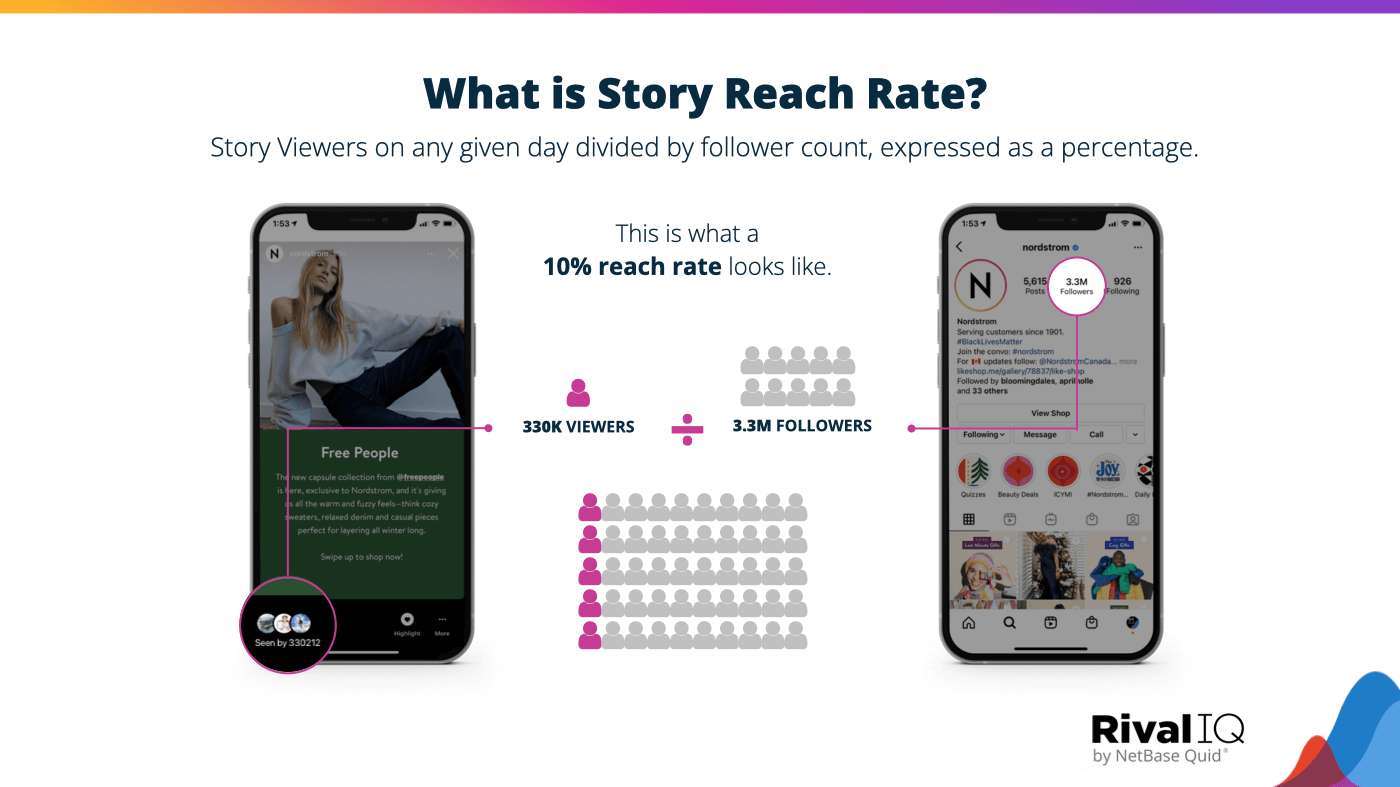
Story reach rates increased or stayed flat for creators in 2023.
- Smaller brands with under 10K followers saw a 35% increase in Story reach rate this year.
- Mid-size brands between 50K-200K followers were the only group to stay flat this year at 1.6%.

Brands are working harder than ever to create dynamic content that grabs attention and keeps it, so a slight uptick in reach rate feels especially heartening. With more creators making Stories and competition from channels like YouTube and TikTok, there’s more competition for every pair of eyeballs that comes across your Story. If you made one change to increase your reach rate, it’s focusing your efforts on creating eye-catching and engaging first frames.
Another tool in your reach toolkit? Story Highlights pin your favorite frames to your profile page and help viewers discover your content long after its 24-hour expiration date in Stories.
Interactive sticker elements like links, shoppable posts, questions, and quizzes can also increase reach.
Post Reach Rate
More good news: post reach rate, which is the percentage of your followers that saw one of your posts, mirrored Story reach rate in increasing just a bit or staying flat for creators this year.
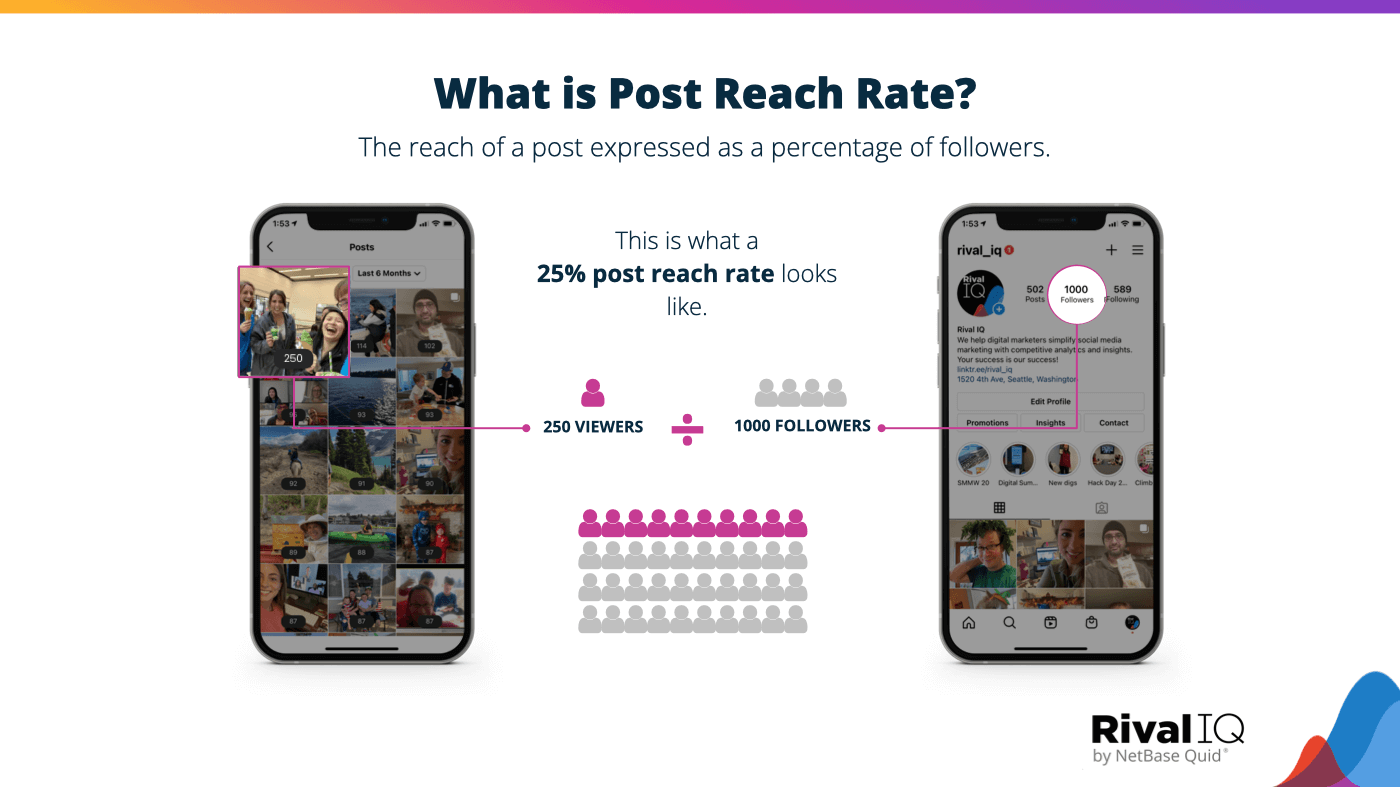
Small handles with fewer than 10K handles saw a 17% increase in post reach rate, while mid-sized brands with between 50K-200K followers saw the only post reach rate decline of the year of 15%.

Post reach rate has been on the decline for a few years running now, so we love to see it on the rise (or heck, flat) for all the brands we studied this year.
Post Reach Rate by Media Type
This metric helps brands understand the reach of a post expressed as a percentage of followers by media type, AKA carousel, image, video, or Reel.
More good news here: brands saw their post reach rates increase for every media type in 2023.
- Images saw the biggest post reach rate increase of 27% over last year.
- Reels saw the smallest increases in reach this year but still showed improvement.

Is Instagram back on top? We won’t know for sure until our 2024 Social Media Industry Benchmark Report comes out, but post reach rate increases across all media types should give creators confidence in investing in the ‘gram in 2024.
Reach Rate: Instagram Stories vs. Posts
Anyone who manages an Instagram account will tell you Stories earn reach that’s dramatically different from posts, so let’s compare the two side by side.
Small brands with follower counts up to 10K can expect around 3x more of their followers to see their posts than their Stories, with brands with larger follower counts seeing a disparity between the two at 5x or larger.

Stories continue to have a lower reach rate than posts for brands, but does that mean your brand should stop creating Stories? The short answer is no: Story impressions can be a great tool for engaging with followers and developing relationships over time.
Posts and Stories engage your followers differently and should be treated as two different tools in a marketer’s toolbox. Posts are great for a quick scroll, but if you hook viewers, Stories can really draw your audience in and keep them engaged.
By the way, if you’re wondering if there’s a right time to post on Instagram or an ideal posting frequency, we’ve got you covered.
Post Engagement per Impression
This metric represents the number of likes, comments, and saves per impression on a post.
Selecting the right denominator in your social media metrics really matters: defining engagement rate as engagements divided by followers will give you a different number than engagements divided by impressions. Whatever your preference, we’ve got you covered with this metric.
It’s worth noting that Post Engagement per Impression is usually available only for brands whose handles you manage, meaning it’s hard to find this metric competitively (unless you’re a Rival IQ Engage Pro customer, because we’ve got estimated impressions right in our app).
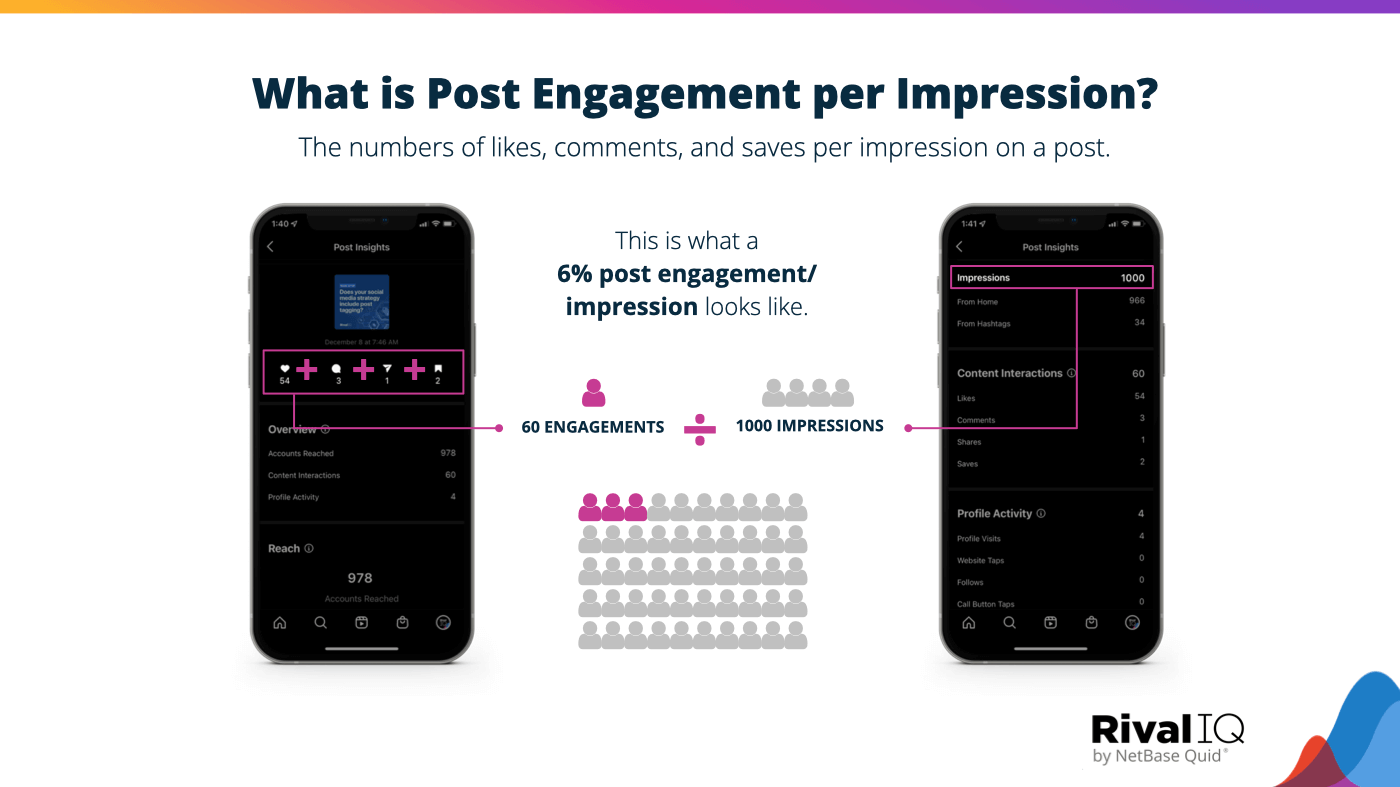
Post engagements per impression increased for all follower counts this year.
- The smallest and largest brands fared the best, with handles in both groups seeing about a 20% increase.
- Small handles with between 10K-50K followers saw their post engagement per impression climb a little less at just 5%.

The rise of post engagements per impression signals a larger trend we’re seeing of Instagram holding onto its relevance in 2024 and beyond.
Post Engagement per Impression by Media Type
Post Engagement per Impression gets even more interesting when you break it down by Instagram post type. And bonus–post engagement per impression increased across every media type in 2023.
- Carousel posts saw the biggest jump in post engagement per impression of more than 25%.
- Video posts held the steadiest, increasing 12% from 2022 in engagement per impression.

Static post types like images and carousels are still outpacing videos and Reels despite Instagram’s big investments in video this year.
Tap-Forward Rate
Tap-Forward Rate measures the percentage of your Story impressions that have a tap forward. It’s an interesting Stories metric because it can indicate both positive and negative attention: either the viewer has had enough of your content, or can’t wait another second to hit the next frame.
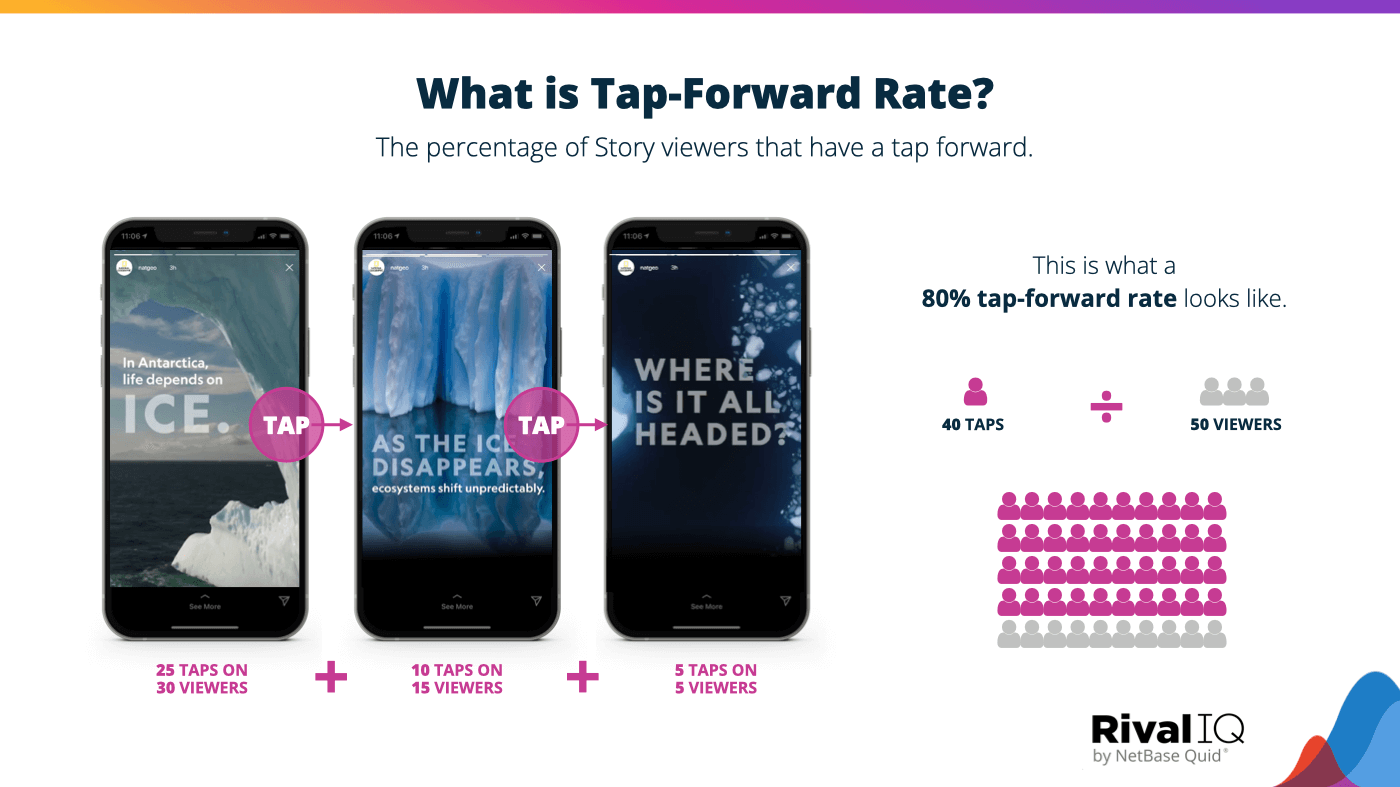
Year after year, we find the more frames in your Story, the more likely it is that followers will tap forward.
- The median tap-forward rate at 5 frames per day is nearly 90%.
- Tap-forward rates stayed flat this year, suggesting attention spans haven’t decreased too much.
- If your Story contains more than 6 frames, more than 90% of your viewers are tapping forward to advance to the next frame.

Tapping forward isn’t necessarily a bad thing, but it does indicate that the viewer has either seen enough of the content or wasn’t interested in the first place. Keep your frames engaging and experiment with video to maintain your viewers throughout the entire Story.
Tap-Back Rate
Taps back indicate that a viewer wanted a closer look or to re-engage with a brand’s content, AKA every marketer’s dream. This rate represents the percentage of Story impressions with a tap back.
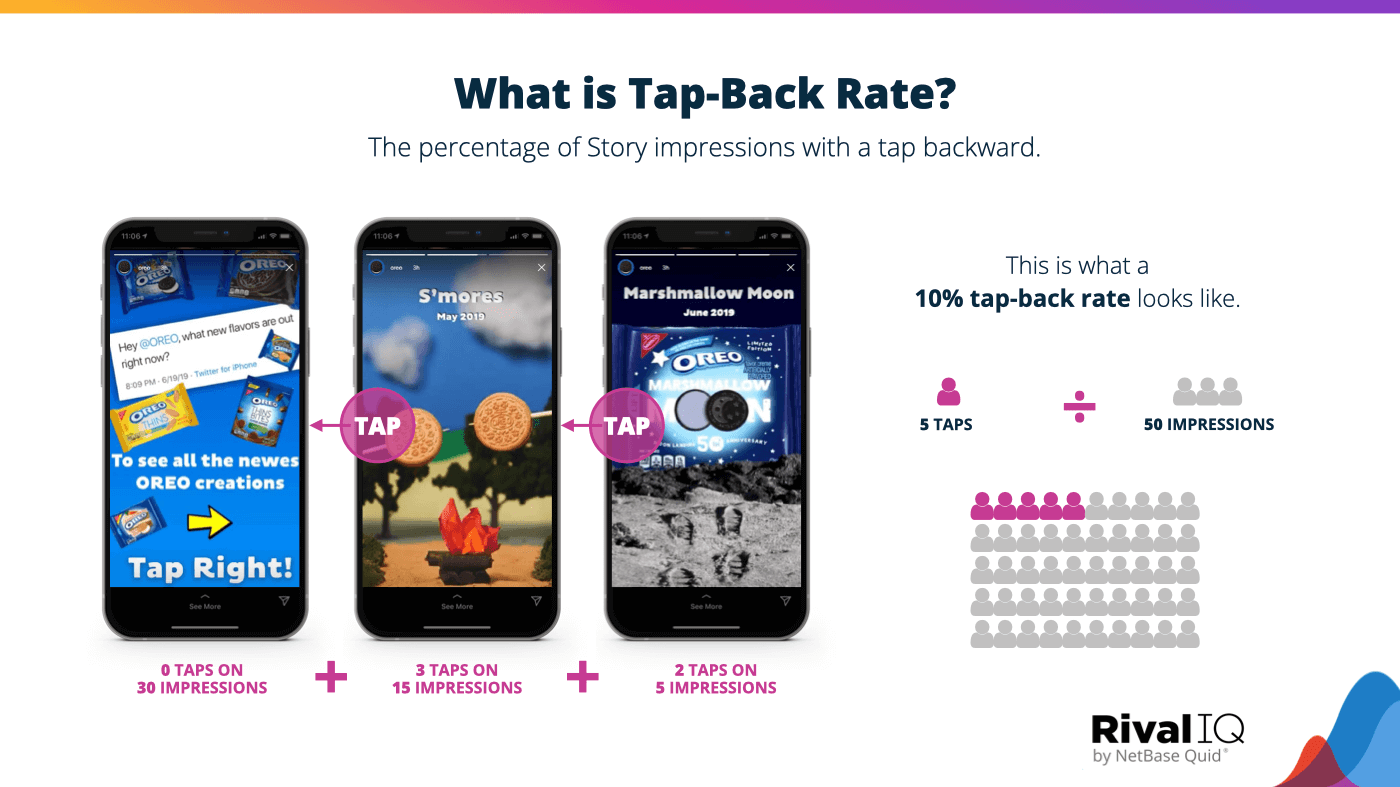
Tap-back rates declined this year (but only by a little). These declines are pretty minimal and not worth losing sleep over.
- The median tap-back rate is 4.6%, but the top 25% of brands see tap-back rates closer to 6.5%.
- Taps back are a great indication of content that your followers want to consume more of.

When reviewing your Instagram Story performance this year, take a look at the Stories or frames that received the most taps back. Were they videos? Did they have a lot of text in them? Be sure to replicate those strategies or other Instagram Story best practices in your content planning.
Replies per 1K Impressions
Replies aren’t the easiest engagement to earn in Instagram Stories, but they indicate serious engagement from a fan or follower. Replies per 1K impressions expresses the number of replies for every 1,000 impressions as a percentage.
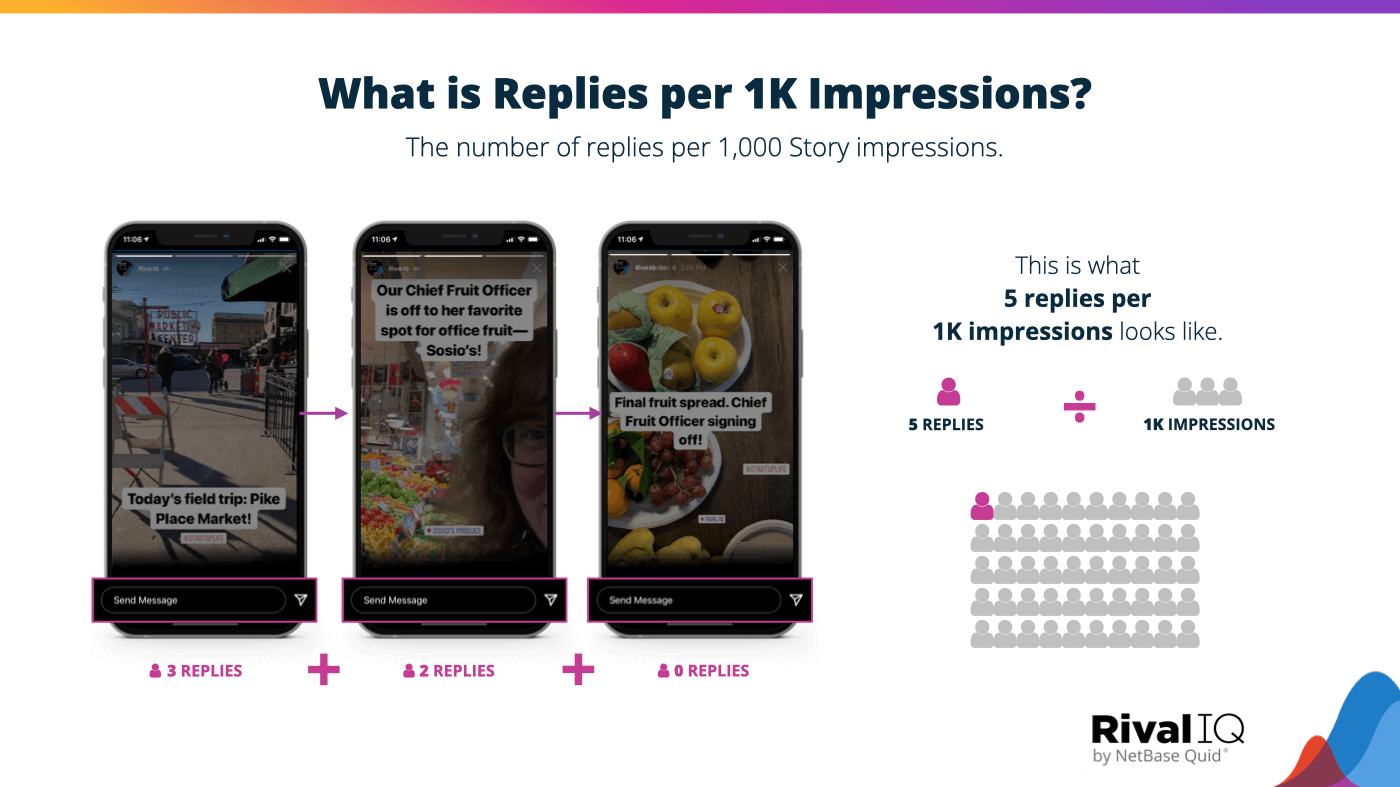
We hate to see it, but replies per 1K impressions fell a lot this year.
- Median reply rates were about half of what they were last year, suggesting people have less to say to the brands they’re following on Instagram.
- These reply rates are tiny because users mostly don’t reply—particularly in the bottom 25%, which has a teeny average reply rate close to 0%.

The best way to score an elusive reply is to ask for one by asking a question. Unfortunately, Instagram’s API continues to limit data from in-frame engagement stickers like polls and quizzes, so it’s tough to measure the impacts of these interactive elements on your engagement and reply rates.
Exit Rate
Exit rates measure the percentage of impressions that nope out of your Story before it ends.
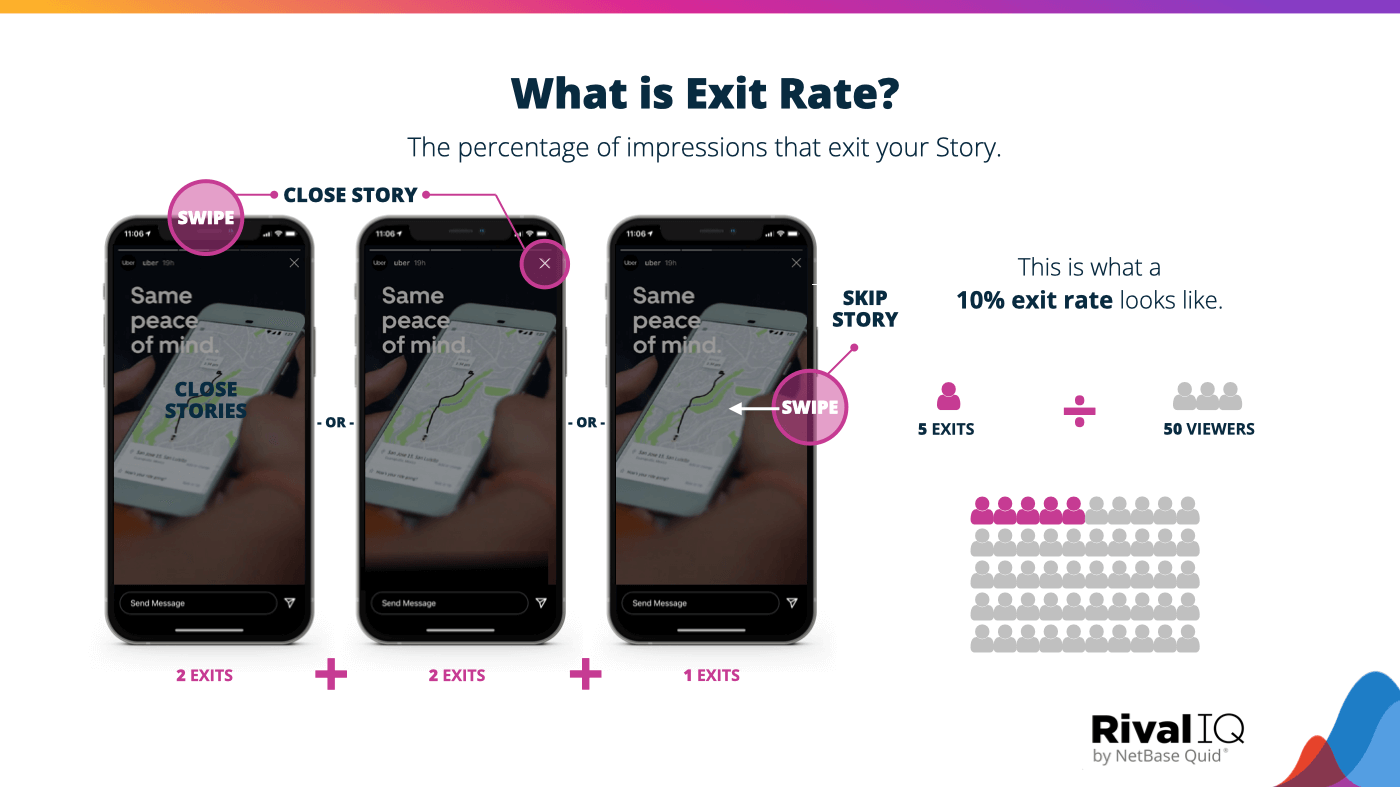
Brands saw exit rates increase just slightly this year, which means viewers were about as likely to bail on a Story as they were last year.
- Exit rates start at about 14% for Stories with a single frame.
- The rate begins to really tail off at 5 frames per day and flattens out in the 5% range.

Exit rates increased a little across all frame per day counts this year, which indicates viewers were slightly quicker to bail on Story content this year. These exit rate numbers are pretty small, so don’t get discouraged.
Wrapping It Up
We hope you enjoyed this deep dive into all things Instagram Stories (and posts, and carousels, and Reels, and videos…) just in time for your 2024 social strategy planning. Social media can feel like a wild ride, which is why we’re so elated to report increases in so many of these stats.
What’s on your Instagram Stories agenda for 2024? Let us know on Instagram!

Start analyzing your brand's Instagram performance with a free Rival IQ trial.
Get my free trialHow to Find your Instagram Stories Data
Follow these simple(-ish) steps to find up to 90 days of Stories data natively in Instagram. Remember that these stats are available only for business profiles, creator accounts, or verified handles.
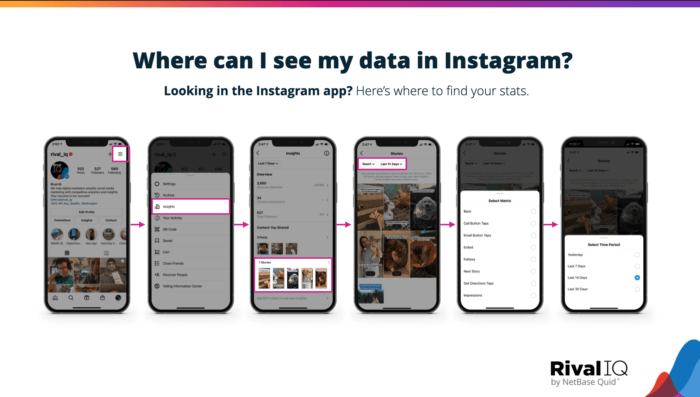
If you’re looking for more than 90 days of Story stats and the ability to view all your Story metrics in one place, you could always start a free trial of Rival IQ or access Instagram Insights in your existing account. Once you connect an Instagram business profile to Rival IQ, you’ll start capturing all your new Instagram Story data (alongside Facebook, Instagram, Twitter, LinkedIn, YouTube, and TikTok stats, of course).
Methodology
Rival IQ analyzed over 125K Instagram Stories (and 539K+ frames!) posted between June and November 2023 to bring you insights for your 2024 marketing strategy.
We included 1470 Instagram handles that had at least one Story published during each month of the time frame, and we only included handles with a reach of at least 100 views for each frame and a 1K total follower minimum. Handles were included only if we had all of their data for the entire time period, regardless of how frequently or infrequently they published Stories. These handles reached across multiple industries, including beauty, media, influencers, outdoor/adventure, marketing, and more.
Instagram Stories Metrics: Glossary
Instagram Story terms don’t have to be confusing, so here’s a glossary of all the important Story metrics used in this report and their definitions.
Engagement: Measurable interaction on Instagram Stories and posts, including likes, comments, replies, and shares.
Exit Rate: The percentage of your impressions that exit your Stories by swiping right, swiping down, or closing Stories.
Frame: A single photo or video posted to your Instagram Story.
Impressions: The total number of views of a frame in your Story.
Post Engagement per Impression: The number of likes, comments, and saves per impression on a post.
Post Reach Rate: The reach of a post expressed as a percentage of your followers.
Reach: The total number of unique people that saw a frame in your Story or your post.
Reply Rate: The percentage of your Story Viewers that replied to your Story on any given day.
Replies per 1K Impressions: The number of replies per 1,000 story impressions.
Retention Rate: The percentage of your Story Viewers on any given day that see all your frames.
Stories Reach Rate: Your Story Viewers on any given day divided by your follower count, expressed as a percentage.
Story: The set of frames posted to your Story within a single 24-hour day.
Story Viewers: The number of people who saw your Story on a given day.
Tap-Back Rate: The percentage of your impressions that have a tap backward to see the previous photo or video again.
Tap-Forward Rate: The percentage of your impressions that have a tap forward to see the next photo or video.
